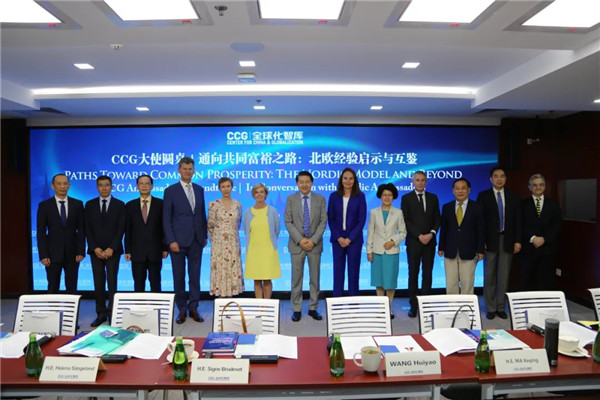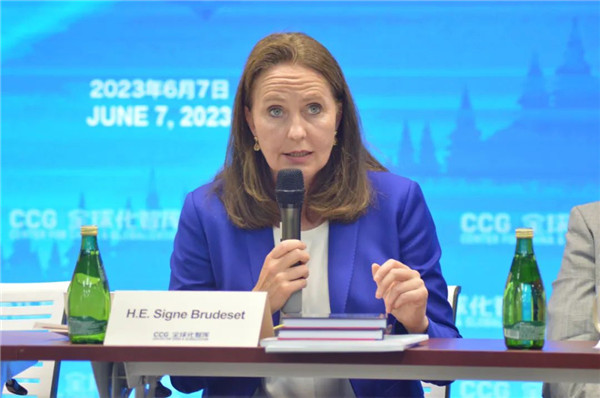H.E. Signe Brudeset Speaks at CCG Ambassadors’ Roundtable
July 17 , 2023In an era of globalization, countries everywhere face daunting socioeconomic challenges. Inequality is rising. Cohesion is weakening as societies undergo identity crises. As governments in search of role models for governance, equality, and social and economic policy, the so-called Nordic model often ranks the top. Practiced in Nordic countries, including Sweden, Norway, Denmark, Finland, and Iceland, the Nordic model is characterized by a state welfare system, access to quality education, and low income disparities, which contributes to the countries’ continued growth and prosperity.
China shares the Nordic countries’ drive to combine market economy and government intervention. As the country seeks to transform its economy and address challenges due to unfettered growth in the past decades, the Nordic experiences may shed light on possible pathways toward the national goal of common prosperity. This event provides highly contextualized accounts of the Nordic model and a discussion about its relevant applications for the future.

At the Center for China and Globalization (CCG) the Ambassadors of the five Nordic countries, Denmark, Finland, Iceland, Norway and Sweden presented different aspects of Nordic governance and practices, including fiscal policy, education, parental leaves, demographic policy, resource management and sustainability, and exchanged views with Chinese scholars and officials on how China can learn and build on Nordic experiences and practices as it works to meet its national goal of common prosperity.

Thank you, Dr. Wang. Dear Henry. Dear friends and colleagues.
First of all, I would like to say thank you very much to CCG for organizing this event. The topic of today, the Nordic model, generally refers to similarities in economic management, the organization of working life, focus on human rights and universal welfare services in the Nordic countries. But it is not a uniform model, but we share similarities.
We have a long tradition of valuable exchanges with Chinese and Nordic experts on our respective society models. In the late 1970s the Norwegian Ministry of Energy and the state-owned energy company Statoil shared experiences with CNOOC on management of the petroleum sector. Later we have had valuable exchanges on pension reform and gender equality. Now green financing is a topic.
Making relevant comparisons between China and the Nordic countries may not intuitively come across as relevant.
The governance models are very different, the size of the populations are miles apart, but still, we share some of the same challenges -aging population, how to tune our education systems for the future labour market, how to avoid increased inequality. Today, I would like to touch on three topics central to the Norwegian governance model. The first is taxation, the second is management of petroleum resources and the third is state ownership.
If you want to understand how a country works, you should study its tax system. This is certainly true for Norway, where taxation issues are among the most hotly debated issues. And I believe the same is true for China. Recently, I had a look at a very interesting book called “Governing and Ruling: The political logic of taxation in China”. The author (Zhang Changdong) points to important dilemmas around taxation and economic growth, taxation and representation, as well as relationships between central versus regional and local authorities.
For Norway’s sake, our tax system is indispensable for securing strong government finances that fuel a sustainable welfare state. Openness and transparency in the tax system are essential values. Although Norway has been blessed with abundant petroleum and natural resources, our workforce is seen as the country ‘s most important resource. The main goal of the Norwegian employment policy is to ensure that as many people as possible participate in the labour market and contribute to society. This is a prerequisite for the sustainability of Norway ‘s welfare schemes; we must create value before we can share value.
A broad tax base founded on a high level of participation in the labor force is necessary to ensure sufficient revenue. But we also believe it promotes fair distribution, value creation, and work incentives. Tax revenues are also used to redistribute, and to reduce inequalities between people socially, economically, and geographically.
The Norwegian system and culture expect that all who are capable of participating in the labour market do so, and seek -through free training and education -to facilitate everyone ‘s inclusion in the workforce. Norway has thus a relatively high retirement age, normally 67 for both men and women. Norwegian policymakers are working for an inclusive labor market that makes it possible for men and women, immigrants, the young, the elderly, and people with disabilities to find gainful employment and continue working longer.
Our high labour market participation, together with a broad tax base, generates income to the state, which in turn can be redistributed for the common good of society. Again – we must create value before we can share value.
Making sure that those with the highest incomes and most wealth contribute most helps generate sufficient revenue and a fair tax burden, but it also fosters trust. Trust in our society is incredibly important.
Income, wealth, and opportunities are often unevenly distributed geographically. To even out these disparities, successive Norwegian governments have developed policies that promote geographical redistribution. Subsidies are offered to various industries located in the periphery, such as agriculture, where national food security is an important aim.
In general, today ‘s public welfare schemes in Norway include free healthcare (beyond a small deductible) and education, generous maternity and paternity leave, retirement and disability pensions, unemployment benefits, 100% sick pay, and other welfare services and benefits. In addition to ensuring a strong social safety net, the interaction between the welfare system and a well-functioning labour market with small wage gaps, has contributed to a high employment rate, low income inequality, a high degree of transparency, equal opportunities, and social trust.
Another important factor for a good and stable Norwegian economy has been responsible management of petroleum revenues.When oil and gas were discovered on the Norwegian continental shelf in 1969, it sparked discussions about how revenue should be handled in order to benefit all Norwegians, including future generations.
In 1990, Norway established a sovereign wealth fund, today known as the Government Pension Fund Global. The state ‘s revenues from oil and gas extraction are now kept in the fund, together with the returns on the fund ‘s investments. The fund ‘s statutes and investment rules are regulated by the Parliament and the organization of the fund is supervised by the Ministry of Finance. But the fund operates independently and free from political interference. The majority of investments are made in low-risk international equities and bonds. The current size of the fund is around $1.4 trillion, which makes it the second largest sovereign wealth fund in the world.
To avoid the so-called resource curse, we have established “the budgetary rule”, which says that “transfers from the fund to the central government budget shall, over time, follow the expected rate of return on the fund”. This is today estimated to about 3%. As significant emphasis is placed on evening out economic fluctuations and contributing to sound capacity utilization and low unemployment, the annual transfers may exceed 3% in difficult times and be well below that in normal times. The transfers are thus used in a counter-cyclical manner into the Norwegian economy. The fiscal policy framework has aimed to preserve the real value of the fund for the benefit of future generations. The revenues that we get today are not for generations today, but also for future Norwegians.
State ownership has also been an important tool for making sure that our common resources benefit all. Private ownership is, as a rule, preferred in Norway ‘s mixed market economy and direct state ownership requires a special justification. In the area of common resources, the state owns a higher share in the domains of energy and the extraction of natural resources, but private companies also participate in this sector and contribute to a competitive business environment.
It is, however, worth underlining that state-owned companies in Norway operate at an arms-length distance from the government, and are subject to the same rules and objectives as privately owned companies. The state can exercise its rights as a shareholder, but the company is managed and operated independently by its management personnel and board of directors. Typically, the government focuses on the rate of return with many state-owned companies listed on the stock exchange and include private shareholders as well.
Creating a perfect system for economic and social governance is nearly impossible, as most variations on any system have their advantages and disadvantages. Nevertheless, economic systems need to be well adapted to the changing situation in the countries that have adopted them, and a fair balance between competing ends and considerations must be found.
Although the Norwegian and Chinese systems and realities differ, we find it to be highly valuable to engage in discussions and experience sharing with Chinese counterparts on such issues. So -thank you very much again to CCG, my Nordic colleagues and the other distinguished participants. I look forward to further exchanges on these topics. Thank you!
Topical News See more






